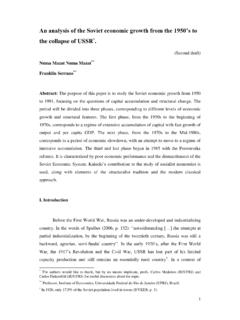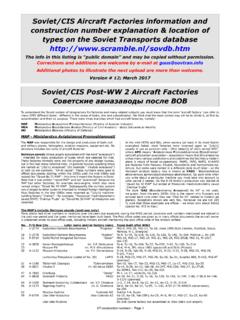Transcription of The New Soviet Defensive Policy: Khalkhin Gol1939 As Case ...
1 The New Soviet Defensive Policy: Khalkhin Gol1939 As Case study CHRISTOPHER D. BELLAMY and JOSEPH S. LAHNSTEIN Mikhail Gorbachev's dramatic changes in the Soviet political and military scene often raise more questions than they answer. One such problematic change to Soviet strategy and operational techniques is the new emphasis on defense. Discussion centers on whether defense in this context means Defensive defense or offensive defense. Soviet analysts have identified four models for a Defensive strategy, and in every case historical analogies are used in their discussion. These are (1) an immediate counteroffensive following an enemy attack (the forces for the coun-teroffensive would in practice be indistinguishable from offensive forces); (2) an initial Defensive phase to draw in the enemy and weaken him prior to a counteroffensive into enemy territory ( the Battle of Kursk); (3) a counterof-fensive that does not enter enemy-held territory; and (4) a highly Defensive model, renouncing all offensive action above the tactical level, using fortifica-tions, strong points, and small local counterattacks.
2 1 There are reliable indica-tions that option three is the front-runner, and the Soviets have claimed that the outstanding example of this option is the Battle of Khalkhin Gol, invol ving Soviet and Mongolian forces against Japanese and Manchukuoan troops, which was fought in August There is certainly much to commend this battle for an important place in Soviet and general military history. It produced a key Japanese defeat which protected the Soviet Union from a two-front war after the German invasion. At Khalkhin Gol the Soviet Union tested many of the operational precepts that matured successfully in the later periods of World War II. It is recognized as an important formative experience for Marshal Georgi Zhukov, arguably the preeminent Soviet commander in World War II.' September 1990 19 Report Documentation PageForm ApprovedOMB No. 0704-0188 Public reporting burden for the collection of information is estimated to average 1 hour per response, including the time for reviewing instructions, searching existing data sources, gathering andmaintaining the data needed, and completing and reviewing the collection of information.
3 Send comments regarding this burden estimate or any other aspect of this collection of information,including suggestions for reducing this burden, to Washington Headquarters Services, Directorate for Information Operations and Reports, 1215 Jefferson Davis Highway, Suite 1204, ArlingtonVA 22202-4302. Respondents should be aware that notwithstanding any other provision of law, no person shall be subject to a penalty for failing to comply with a collection of information if itdoes not display a currently valid OMB control number. 1. REPORT DATE 1990 2. REPORT TYPE 3. DATES COVERED 00-00-1990 to 00-00-1990 4. TITLE AND SUBTITLE The New Soviet Defensive Policy: Khalkhin Gol 1939 As Case study 5a. CONTRACT NUMBER 5b. GRANT NUMBER 5c. PROGRAM ELEMENT NUMBER 6. AUTHOR(S) 5d. PROJECT NUMBER 5e. TASK NUMBER 5f. WORK UNIT NUMBER 7. PERFORMING ORGANIZATION NAME(S) AND ADDRESS(ES) Army War College,ATTN: Parameters,122 Forbes Avenue,Carlisle,PA,17013-5238 8.
4 PERFORMING ORGANIZATIONREPORT NUMBER 9. SPONSORING/MONITORING AGENCY NAME(S) AND ADDRESS(ES) 10. SPONSOR/MONITOR S ACRONYM(S) 11. SPONSOR/MONITOR S REPORT NUMBER(S) 12. DISTRIBUTION/AVAILABILITY STATEMENT Approved for public release; distribution unlimited 13. SUPPLEMENTARY NOTES 14. ABSTRACT 15. SUBJECT TERMS 16. SECURITY CLASSIFICATION OF: 17. LIMITATION OF ABSTRACT Same asReport (SAR) 18. NUMBEROF PAGES 14 19a. NAME OFRESPONSIBLE PERSON a. REPORT unclassified b. ABSTRACT unclassified c. THIS PAGE unclassified Standard Form 298 (Rev. 8-98) Prescribed by ANSI Std Z39-18 Map 1: Disputed Area, Northwest Manchuria The Khalkhin Gol incident is best approached within the context of the Sino-Japanese War of 1937-45. The Japanese, having long sought to replace the Chinese and Russians as the dominant power factors in Manchuria, succeeded in establishing a puppet state there in 1931 which they called Manchukuo.
5 With the advance of Japanese imperialist ambitions in the late 1930s, the Soviet 's own satellite state-the Mongolian People's Republic-began to feel the pressure. Lying adjacent to and immediately to the west of Manchukuo, the Mongolian People's Republic-seconded by the Soviets-disputed Manchu-kuon dynastic claims to a 25-kilometer-wide strip of land lying between the Khalkhin Gol (the Halha River) and the town of Nomonhan to the east. In other words, Manchukuo, backed by Japan, claimed that the Khalkhin Gol marked the border between the two states, while the Mongolian People's Republic and the Soviets insisted on a border lying farther to the east, on a line running generally southeasterly through Nomonhan. The situation came to a head in May 1939 when Soviet troops occupied the disputed territory between the Khalkhin Gol and Nomonhan. The Japanese attacked with a reinforced division and were initially successful.
6 Thus the stage for Khalkhin Gol was set. 4 20 Parameters If Khalkhin Gol evinces the Soviet Union's current views about defen-sive concejlli,llJihould mtSWeL ~T-h%4jJltinGtive------ feature of this option is that the action remains confined within the territory being defended. But what is the legitimacy of the claim that the battle occurred only as a result of a Japanese incursion into the recognized territory of a Soviet ally, specifically the Mongolian People's Republic (MPR)? That is the first question. Second, how did differences in organization, equipment, and national commit-ment affect the battle's outcome? Third, what is peculiar to the Soviet operational techniques used in the battle which gave it a Defensive nature? Last, what does Khalkhin Gol as part of the Soviet -Japanese conflict of 1939 tell us in general about the Soviet Union's view of limiting conflict? Whose Side of the Wire?
7 Conflict between Japan and the USSR in the 1930s was almost inevitable. Severe fighting between the Soviets and Japanese had already taken place a year earlier (11 July-IO August 1938) at the site of a dispute over a poorly defined border area at the junction of Manchukuo, Korea, and Siberia. The boundary dispute regarding the Khalkhin Gol was over 200 years old.' Disputes among warring Mongol factions to secure a scarce water source for their herds led to an acceptance of a transparent border in the Khalkhin Gol basin. Imperial Russian incursions into an increasingly fragmented China became exacerbated by the two even more dynamic and expansionist powers: Imperial Japan and Soviet Russia. Though the Soviets had good cause to worry about their interests, the open hostility to the Soviets manifested by Japan's Kwantung Army in Man-chukuo was diametrically opposed to the attitudes of the Japanese Foreign Ministry.
8 The Japanese central government had no intention of provoking war with the Soviet Union in any circumstances and wished at all costs to limit the Christopher D. Bellamy is a research analyst in the Center for Defence Studies, University of Edinburgh, Scotland. He has served as an officer in the Royal Artillery and holds a first degree in modem history from Oxford University, a master's with distinction in war studies from King's College, London, and later a (Honors) in Russian from the Polytechnic of Central London. He is the author of Red God of War: Soviet Artillery and Rocket Forces (1986), The Future of Land Waifare (1987), and The Evolution of Modern Land Warfare.' Theory and Practice (1990). He also was Consultant Editor on the Soviet ~German war for The Times Atlas of the Second World War (1989). Lieutenant Colonel Joseph S. Lahnstein was the US Army Research Associate in Defence Studies, University of Edinburgh, 1988-89.
9 He is a graduate of Syracuse Univer-sity and holds a master's degree in national security affairs from the US Navy Postgraduate School. A graduate of the Command and General Staff College, he completed Foreign Area Officer training at the US Army Russian Institute. He is currently Chief, Soviet ! Eastern European Division, Joint Intelligence Center, Europe, US European Command. September 1990 21 damage done to their relations by disputes over historically ill-defined borders. What the Japanese civil government wanted desperately was a set of recognizable and set boundaries between the Soviet Far East and Manchuria. To that end the Japanese government embarked on a policy of seeking negotiations to demarcate the border regions from 1935 onward. The lack of success in these negotiations implied that the border disputes would be solved only by force of arms. This puts the question, "Whose side of the wire?
10 " into a different context, making fixing the location of the wire an issue. Several factors, such as the control of the Khalkhin Gol drainage basin and its flow into Lake Buir, fueled the conflict over this semi-arid stretch of Asian steppe. Sensitivity of the Soviet Union to its own border integrity and the Mongolian political situation also played a role; the MPR's position as a new fraternal socialist country and its internal instability created a climate which invited the Soviet Union to take an active interest. The Soviet assertion that they fought the battle in August 1939 to repel Japanese invaders can therefore more properly be characterized as a determination on the Soviets' part to settle a dispute over an undefined border by force of arms. The Soviet Union was defending its client's border claim based on its own interests, as against competing and similar Japanese claims. General Strategic Situation The Far Eastern USSR prior to and during World War II, which formed a strategic horseshoe around Japanese-occupied Manchukuo, remained critically dependent on the trans-Siberian railroad.
















